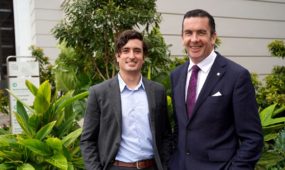Wings to fly: how joining forces brings rewards in defence industry
Defence
WHEN aviation services company Cobham won a $640 million contract in October 2014 to provide search and rescue capability for the Australian government, it wasn’t only the company’s 400-strong South Australian workforce popping the champagne corks in celebration.

Sign up to receive notifications about new stories in this category.
Thank you for subscribing to story notifications.
WHEN aviation services company Cobham won a $640 million contract in October 2014 to provide search and rescue capability for the Australian government, it wasn’t only the company’s 400-strong South Australian workforce popping the champagne corks in celebration.
For while the win was a major coup for the Adelaide-based group, the 12-year contract also signalled that The Australian Aerospace Alliance formed in 2013 under the guidance of the Defence Teaming Centre (DTC) had come of age.
Cobham is anticipating about 10 of its fellow Alliance members will secure work – ranging from minor manufacturing to sophisticated systems development – as part of the contract; a clear demonstration that the collaboration and teamwork required under an alliance model can indeed result in everyone gaining a ‘bigger share of the pie’.
And as the DTC gets set to officially launch the Alliance at the Avalon Air Show in March, there is much optimism about the potential to land big contracts in the coming year, particularly in the civil aerospace market.
The idea of creating an alliance was first raised in mid-2013 when a core group of South Australian businesses believed they would have greater opportunities in the defence and aerospace industries if they utilised each other’s skills. A groundswell of interest from other SMEs keen to participate ensued and a strategic alliance was formed.
Over the past 12 months there has been considerable effort and attention to getting the rules and regulations governing the Alliance in place and the Cobham contract with the Australian Maritime Safety Authority is a clear indication that the pieces are now falling into place.
Tim Dore, Manager, Defence and Security at Cobham Aviation Services, says that being part of the Alliance helped the company provide a competitive bid for the contract because it could draw on the skills of fellow member companies to meet the customer’s needs.
“We’re a large company, but we don’t do everything and sometimes it’s really handy to know what is in our backyard.
“These days the tender process is so tight – sometimes just three to four weeks – so there’s a chance you’ll miss local skills and SMEs if you don’t already know they exist.
The Alliance brings that skill set together. It provides greater visibility and makes things easier because it is a one-stop shop,” he explains.
Kerryn Smith, Deputy CEO and General Manager of Capability Development at the DTC has been involved with the Alliance since the start and says there has been much consultation with members to ensure future growth is based on principles of good governance, a set of definitions, vision, mission and values that will guide its work and behaviour.
A marketing plan and business plan have been prepared, which provide clear targets and areas of opportunity for the next 12 months. An Advisory Board will be established and steering committees will oversee each of the five key capability areas of the Alliance: avionics systems and electronic products; software solutions; autonomous systems; advanced manufacturing; and aircraft sustainment.
Smith says that to ensure there are suitable capabilities in each of these areas, more members will be brought in to join the 20 companies that currently form the Alliance.
“Already the Alliance has looked at other suppliers from other states that might play a key role in the Alliance. It was always the intention that the Alliance would be a national entity, based here, but with a national reach.
“This is the only way to go in order to get into the global marketplace. Overseas markets don’t see the borders between South Australia and Queensland and New South Wales and Victoria – they just see Australia.
“In the early days of the Alliance forming, some of the SMEs noted they had been offered great opportunities over the years, but did not have the capacity to service them and reluctantly had to let them go. Now they can bring those opportunities to the Alliance if they need other members to service it,” Smith says.
As outlined in a progress report released late last year, the greatest opportunities for the Alliance are in the commercial aviation sector.
The annual production of commercial aircraft is projected to increase by an estimated 25% by 2023, driven somewhat by the greater purchases of commercial passenger aircraft in developing regions such as the Middle East, China and South East Asia.
“This exponential growth in the civil aerospace market over the next 20 years is set to see the demand for travel and the numbers of aeroplanes double with over 35,000 new passenger aircraft being required,” the report states, adding, “This, combined with the growth in the number of freighter aircraft, provides a positive growth outlook within the civil aerospace market with Asia leading the way in increasing air passenger traffic by 4.7% per annum and freight traffic by 4.8% per annum over the next 20 years.”
The DTC is already helping members of the Alliance to tap into this growth sector through a number of trade delegations and organising meetings with trade ambassadors from countries including Singapore, Poland and Egypt.
Under its marketing plan, over the next 12 months the Alliance is hoping to achieve sales totalling $100 million from new and existing contracts, while securing 10 new contracts and acquiring 25-50 new leads.
The figures seem optimistic, however, one of the founding members of the Alliance, Paul Levett of Levett Engineering, believes the sky really is the limit if members work together to get a slice of the global commercial aircraft pie.
“What is happening is there are more titanium composite-skinned aircraft and jet engines are now more fuel efficient, so the whole global fleet is being upgraded and the market is growing at the same time. It’s huge and it’s just a matter of getting your foot in the door and demonstrating you have the capacity and capability to do the work and be globally competitive.
“It needs to be demonstrated that the Alliance is a one-stop shop when facing international primes, so we can give them confidence to put work into Australia.”
Levett’s company has more than a decade of experience in the global supply chain working on the Joint Strike Fighter program, but he says being part of the Alliance is vital if Levett is to win bigger contracts.
“While we have been successful in securing aerospace work, there are a lot of jobs we come across that are more complex and need a lot more capability than Levett offers on its own.
“Opportunities get presented to us and rather than walking away, by creating this Alliance where each company can add value and capabilities, it enables us to act as one and effectively take on larger projects,” he says.
Levette admits that for some companies in the Alliance it can be difficult to get past the competitive aspect of being in business.
“Over the past 12 years since we first started going down the aerospace track, you tended to have the mindset of just looking after things in your own backyard and being closely guarded with things,” he says. “While it’s fine saying you need to act as one, you need a good trust basis to do this. You’ve really got to change your mindset and while it all sounds good in theory, putting it into action is the difficult part.”
Chairman of the Alliance and another founding member, Darryl Mincham of Mincham Aviation, agrees that it can be difficult to work in a collaborative environment, but says presenting a united front is a “smarter way of doing business”.
“In the past, a company would have said a job was outside their capabilities and ‘we can’t help you’. Now members are actively saying, ‘I can’t help you, but I know someone who can’. It’s really opening up a whole new way of doing business in a community mentality,” he says. “By breaking down the barriers and understanding what is required in teaming, it means we can work together smarter on national and international initiatives.”
Since the establishment of the Alliance, Mincham has been a driving force in ensuring the core foundations of a long-term alliance model are in place.
“Members had numerous sessions setting up strategy and the long term aspirations and objectives of the Alliance. It was fundamental that we didn’t rush this and got a good sound foundation in place and it is going to plan nicely,” he says.
Once the Advisory Board is in place, the structure will be very similar to a DTC association model, with all the tools and templates that industry requires to “drive cost out of its baseline and bring the skill sets up in the industry”.
For some companies, joining the Alliance has been a way of securing their survival as they can tap into the much larger resources available.
“Instead of every company going out with their own business development team trying to win work internationally, all of a sudden you have 20 companies with 30 business development people out there advocating on behalf of not only their company, but all the capabilities within Australia. It widens the catching mitt,” says Mincham.
The Alliance is talking with international Primes – such as Northrop Grumman and Boeing – which have shown interest in the initiative and Mincham is confident that over the next 12 months there will be further announcements of contract wins.
“Already with some of the incubating projects there are some promising outlooks and we anticipate some successes,” he says.
“We’re getting feedback from a lot of the global supply chains and they are very excited by what we are doing. Already the Airforce is talking with us about how we can better service one another.”
While gaining work is the number one priority, Mincham believes members of the Alliance are also fulfilling a “moral and ethical” obligation to provide opportunities for future generations involved in the aerospace industry.
“One of the trends over the past 10 years has been losing business offshore. We’ve lost thousands of jobs offshore. What we need to do as an industry is drive our costs down and take control of the things we can control – and start bringing work back into Australia,” he says.
“We are absolutely determined as an industry body to ensure we get it right this time. We have seen so many failed initiatives over the past 20 to 30 years and we’ve said enough is enough, we as industry are standing up and leading this – and it must succeed.”
No doubt other industries will be watching closely to see if this model can achieve the success many are predicting and if a national Aerospace Alliance really does have wings to fly.
The Alliance will be exhibiting as part of the “South Australia Defence State” stand at Avalon in Victoria, Australia.
Jump to next article



